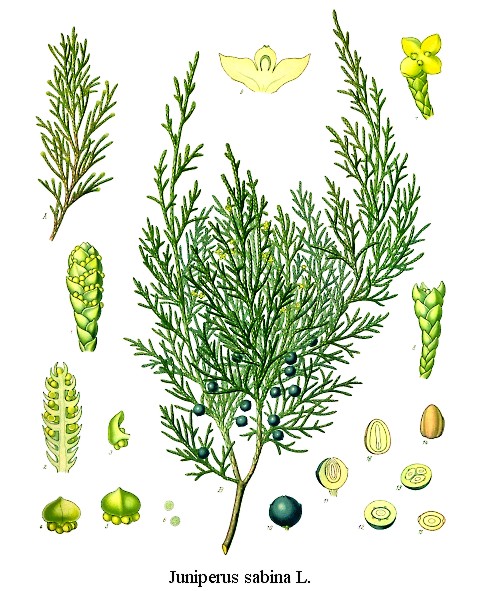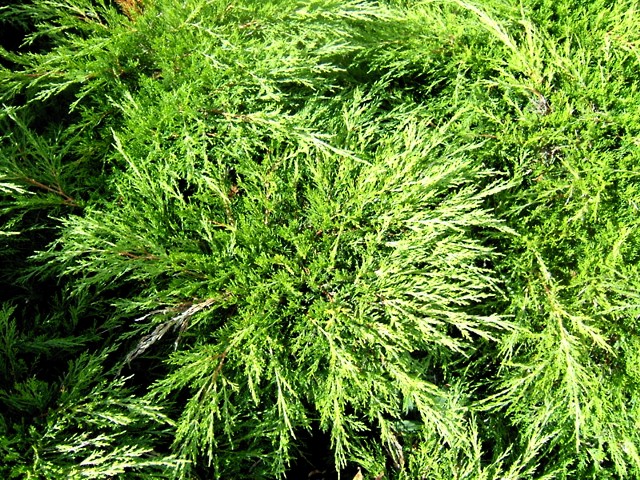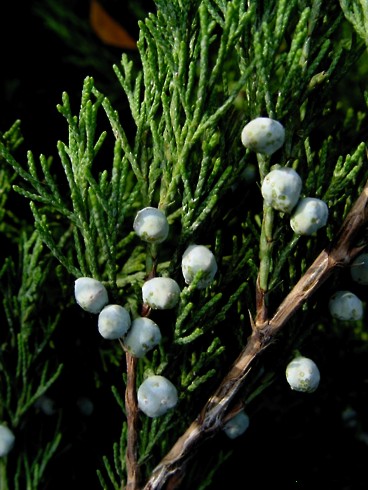Lessico
Erba
sabina
Juniperus sabina

L’erba sabina - Juniperus sabina - appartiene alla famiglia delle Cupressacee, diffusa nelle zone submontane dell'Europa meridionale e dell'Asia centrale. È un piccolo arbusto strisciante, con rametti terminali brevi, sottili e foglie squamiformi, embricate, munite di una ghiandola alla base della faccia esterna, di colore verde pallido, odore di trementina e sapore acre e amaro. I rametti terminali della sabina, che contengono dal 2% al 3% di olio essenziale, sono stati usati in medicina come emmenagogo e per preparare empiastri rubefacenti. Volgarmente è nota come pericoloso abortivante.

Dioscoride![]() - De materia medica 1-104. brathus - suggested: Sabina [Fuchs
- De materia medica 1-104. brathus - suggested: Sabina [Fuchs![]() ], Sabina folio tamarasci
Dioscoridis [Bauhin], Brathys, Brathus [Latin], Juniperus
sabina [Linnaeus], Herba sabina — Savin, Sabin. - There are two kinds of savin. One has leaves like
cypress, but is more prickly with a strong smell, and sharp with a hot nature.
The tree is short and extends itself mostly in breadth. Some use the leaves
for perfume. The other kind has leaves like myrica [1-116 Tamarix
germanica Linnaeus]. Applied as a poultice the leaves of either of
them close stomas [openings] and alleviate inflammation. Similarly,
applied as a plaster with honey, they take away all blackness and foulness,
and they break up carbuncles [infected boils]. Taken as a drink with wine (as
well as applied or by inhalation) they draw out blood through the urine, and
drive out the birth. They are mixed with hot ointments and in particular with gleucinum
[1-67 Syruped Pulp of Grapes in Oil, Oil of Must]. Some call it barathrum,
some baryton, and the Romans call it herba sabina. (traduzione di Tess Anne Osbaldeston)
], Sabina folio tamarasci
Dioscoridis [Bauhin], Brathys, Brathus [Latin], Juniperus
sabina [Linnaeus], Herba sabina — Savin, Sabin. - There are two kinds of savin. One has leaves like
cypress, but is more prickly with a strong smell, and sharp with a hot nature.
The tree is short and extends itself mostly in breadth. Some use the leaves
for perfume. The other kind has leaves like myrica [1-116 Tamarix
germanica Linnaeus]. Applied as a poultice the leaves of either of
them close stomas [openings] and alleviate inflammation. Similarly,
applied as a plaster with honey, they take away all blackness and foulness,
and they break up carbuncles [infected boils]. Taken as a drink with wine (as
well as applied or by inhalation) they draw out blood through the urine, and
drive out the birth. They are mixed with hot ointments and in particular with gleucinum
[1-67 Syruped Pulp of Grapes in Oil, Oil of Must]. Some call it barathrum,
some baryton, and the Romans call it herba sabina. (traduzione di Tess Anne Osbaldeston)
